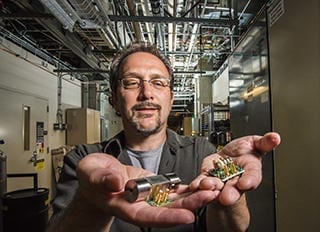
Tiny detectors that can sniff out everything from explosives and biotoxins to smuggled humans
Sandia National Laboratories scientists are thinking small, building on decades of sensor work to invent tiny detectors that can sniff out everything from explosives and biotoxins to smuggled humans.
Their potential seems unlimited. The military needs to find low concentrations of chemicals, such as those used in roadside bombs or chemical warfare agents, before they hurt anyone, said researcher Ron Manginell. Soldiers often use detectors in less-than-ideal situations, looking for dangerous substances from among a rich miasma of diesel fumes, smoke and dust. They carry detectors into the field, where instruments must be portable, rugged, reliable and easy-to-use. In addition, inspectors at checkpoints and border crossings that see large numbers of containers lack automated ways to find trafficked people or contraband.
In the late 1990s, Sandia developed a simple-to-use handheld chemical detector for the military, the MicroChemLab. Ever since, Sandia has improved such microfluidics- and microelectromechanical (MEMS) systems-based instruments that identify chemicals based on gas chromatography, or GC, and resonator-style instruments such as surface acoustic wave (SAW) detectors.
Detection world needs new instruments
Manginell said SAW-based instruments will continue to be extremely important. But the world of detection also needs new instruments that can find compounds such as carbon dioxide, chemical signals unique to humans or the volatile signatures of pathogens and diseases in livestock and humans.
Manginell led a project to develop such a detector and couple it with GC. Together, they identify vapors by “sniffing” volatile organic compounds (VOCs). The prototype of the new detector, a miniature pulsed-discharge ionization detector, or mini-PDID, is about 1 inch by 1 inch by 2 inches, can be coupled with commercially produced micro-GCs and can run for nine hours on a charge of helium.
Experiments have shown the mini-PDID can detect explosives-related compounds, pesticides and toxic industrial compounds. “These are nasty things,” Manginell said. The detector also homes in on signatures of human odors and bacteria, light gases such as carbon monoxide and carbon dioxide and a broad range of organic compounds.
“We now have new detectors, like the PDID, with higher sensitivity and broader applicability that would integrate well with the SAW and micro-GCs to provide both sensitivity, the ability to detect a few molecules of a given compound, and selectivity, the ability to distinguish compounds from one another,” Manginell said. A miniaturized vapor detection unit and subsidiary electronics could fit in a format no larger than a cell phone, he said.
Looking at a detector for human cargo
The mini-PDID’s universal detection abilities are allowing researchers to look at vapor detection of bacteria, an approach aimed at bringing biological and chemical detection into a small, common platform, Manginell said. He highlighted the work, funded by Sandia’s Laboratory Directed Research and Development program, in a presentation at last fall’s International Breath Analysis meeting in Sonoma, CA. The Journal of Breath Research published a paper by the team in July 2013.
The team demonstrated the possibility of a VOC-based detector for humans as part of the project.
“People are brought across the border for many reasons, sometimes for a better life, sometimes for malevolent reasons” such as drug, weapons or explosives smuggling, Manginell said.
Current commercial detectors to find human cargo are about the size of a large shoebox, minus the electronics that operate them. Thus, Manginell’s team saw promise for a miniature vapor-based detector for what he calls “indications of human presence.”
In other words, sweat.
The Latest Bing News on:
Detection instruments
- Geneva County Police unveil new drug detection deviceon May 17, 2024 at 6:08 pm
We have a whole litany of different drugs we have to deal with now,” said Chief Pepper Mock of Geneva County Police.
- Investing in debt instruments? Learn how agencies give them credit ratings as Sebi releases master circularon May 17, 2024 at 5:18 pm
From time to time, Sebi has released circulars to make a set of rules which govern the criteria for credit rating agencies. The regulator has now released a master circular to enable the investors to ...
- Advance Microbial Detection with Metagenomic Techniqueson May 17, 2024 at 11:57 am
Microbial detection is arguably more important than ever.
- CBP Eyes Leidos for Follow-On Border Detection System Maintenance Support Contracton May 17, 2024 at 2:33 am
The U.S. Customs and Border Protection has announced plans to award Leidos (NYSE: LDOS) a recompete contract for corrective and preventive maintenance support services for CBP’s non-intrusive ...
- Governor DeWine awards more than $2M in H2Ohio grants for public drinking water distribution system equipmenton May 16, 2024 at 7:30 pm
Ohio Governor Mike DeWine and Ohio EPA announced Thursday $2.2 million in H2Ohio grants for more than 250 communities in 78 counties to help pay for equipment needed to maintain public drinking water ...
- MIT Engineers Create Game-Changing Lead Detection Deviceon May 16, 2024 at 5:01 pm
A new chip-scale device could provide sensitive detection of lead levels in drinking water, whose toxicity affects 240 million people worldwide. Engineers at MIT and collaborators have developed a ...
- DeWine Awards More Than $2 Million in H2Ohio Grants for Public Drinking Water Distribution System Equipmenton May 16, 2024 at 11:30 am
May 16, 2024, Press Release from the Office of Ohio Governor Mike DeWine: (COLUMBUS, Ohio)— Ohio Governor Mike DeWine and Ohio EPA announced today $2.2 million in H2Ohio grants for more than 250 ...
- Revealing Metal Detection Challenges for Dairy Applicationson May 15, 2024 at 6:35 am
Changing characteristics, product and orientation effect can disrupt product signals and affect detection sensitivity if not addressed. However, digital technologies and machine learning are pushing ...
- MRI scans promise early heart failure detection in women, British study findson May 15, 2024 at 5:05 am
British researchers said Wednesday that they have developed a new way of using Magnetic Resonance Imaging to detect heart failure in women that will boost diagnosis rates, allowing more women to get ...
- State Governments Could Soon Approve Funding for AI-Powered Gun Detection Systems in Schoolson May 12, 2024 at 8:10 pm
To guarantee student safety on campuses, AI-powered gun detectors prove to be the trend. Most recently, in March, schools were offered AI-powered gun detection equipment by Silicon Valley startup ...
The Latest Google Headlines on:
Detection instruments
[google_news title=”” keyword=”detection instruments” num_posts=”10″ blurb_length=”0″ show_thumb=”left”]
The Latest Bing News on:
Detector for human cargo
- Best Carbon Monoxide Detector for 2024on May 15, 2024 at 2:52 am
CNET’s expert staff reviews and rates dozens of new products and services each month, building on more than a quarter century of expertise. Your home can slowly be filled with carbon monoxide ...
- Best Smoke Detector for 2024on May 14, 2024 at 7:00 am
Laboratory Technical Project Manager Gianmarco Chumbe has been part of the CNET Home team since 2018. He is in charge of developing and carrying out testing procedures for a wide variety of home ...
- Tested: Best Radar Detectors for 2024on May 10, 2024 at 5:00 pm
"Do you know how fast you were going?" We've all heard that before, and there's no good answer. Navigation apps such as Waze have gained popularity for sounding the alarm on potential speed traps ...
- The 9 Best Metal Detectors, According to Expertson April 24, 2024 at 4:05 pm
Whether stashed by Captain Kidd or as a plot point in The Goonies, buried treasure has a certain allure to it. But while metal detecting is a well-established hobby with thousands of dedicated ...
- Your Ultimate Carbon Monoxide Detector Guideon April 18, 2024 at 7:24 am
The CDC estimates over 50,000 carbon monoxide poisoning emergency room visits result in over 400 deaths yearly. Carbon Monoxide is an odorless, tasteless, and colorless gas produced when burning a ...
- Your Ultimate Smoke Detector Guideon April 18, 2024 at 5:29 am
Every year there are almost 400,000 house fires that cause between 3,000 and 4,000 deaths and even more injuries. Sadly, half of all house fire-related deaths occur in homes with working smoke ...
- 5 best metal detector apps for Android that actually workon April 17, 2024 at 5:00 pm
This article was updated and checked for accuracy in April 2024. It was originally published in 2021. Believe it or not, metal detection is actually possible on Android phones. In fact, the first ...
- Particle Detectorson April 4, 2024 at 5:28 am
Elementary particles can be identified through various techniques, depending on the purpose of the measurement and which relevant quantities, such as time, energy, and spatial coordinates, have to be ...
- Joint Chemical Agent Detectoron March 2, 2024 at 8:40 am
The Joint Chemical Agent Detector (JCAD) M4A1 is a pocket-size, rugged, handheld detector that automatically detects, identifies, and alarms to chemical warfare agents and toxic industrial ...
- DIY Metal Detectoron May 7, 2023 at 9:47 pm
If you want to get rich by hunting with a metal detector, you might want to consider how much you invested in the hardware to start with. Finding a tin can with a $200 detector might not make ...
The Latest Google Headlines on:
Detector for human cargo
[google_news title=”” keyword=”detector for human cargo” num_posts=”10″ blurb_length=”0″ show_thumb=”left”]











